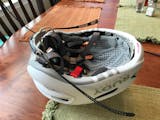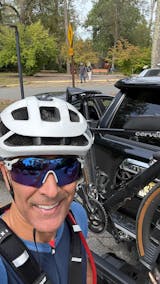How to Choose a Mountain Bike Helmet

High-quality mountain biking helmets share their structural foundation with road cycling helmets and a variety of safety features and technical specs. To wit: Both will carry a safety rating/certification from the Consumer Protection Safety Commission (CSPC), and some will also meet European safety standards (EN 1078).
This system allows the helmet to rotate inside itself thanks to a low-friction layer that disperses lateral forces; rather than subjecting the head and brain to absorb all that rotational force. Beyond these key safety elements, mountain bike helmets look and function much differently than their roadie brothers and sisters. Generally speaking, MTB lids fall into three categories: cross-country, trail or all-mountain, and downhill.
Cross-Country Mountain Bike Helmet
These helmets look much closer to road cycling helmets than to trail or downhill lids. They usually have a lower rear than roadie helmets but a heavier, beefier hard shell and thicker foam layer. They come with noticeably more ventilation holes than trail or downhill lids, which makes them a better choice for long rides in hot climates or long, multi-hour climbs up mountains.
Choose If: You ride fast over varying terrain or compete in ultra-endurance events such as the Leadville Trail 100 or a 24-hour race.
Bike Type: A lightweight, hardtail mountain bike built for speed and racing.
Trail / All-Mountain Helmet
As the name implies, a trail or all-mountain bike helmet does it all. These lids, known as half-shell helmets, offer more protection behind the ears and across the back of the neck, with the foam and hard shell outer layer wrapping around the back to the head. This form better protects against backward falls. These all-rounders use fewer but strategically-placed vents to boost protection over ventilation. Last, a trail helmet will have a wide visor across the front to block the sun, rain, or even some bushes or branches from hitting your eyes. Some, like Rudy Project’s Protera+, make the visor adjustable, letting it move up or down to integrate easily with goggles. The Protera+ even adds a goggle retainer in the back to hold goggle straps in place.
Choose If: You tackle any mountain bike adventure: singletrack, pump track, or downhills–these helmets are the go-to for fun days on dirt.
Bike Type: Anything from a hardtail to a dual-suspension trail bike.
Downhill, Freeride Helmet
Downhill or freeride mountain bike helmets look more like motocross helmets than bike helmets. They feature full-face protection with a chin guard, few ventilation holes, and full coverage over the ears, jaw, and around the back of the head. Since many downhill bikers use a ski lift or shuttle to ferry them to the top of the mountain, staying cool from arduous climbs is not an issue. Maximum safety is.
Choose If: You live for lift-served mountain biking featuring big jumps, drops, or high-speed technical descents over rocks and roots. The same goes for big jumps at a freeride park.
Bike Type: Downhill/freeride dual-suspension bikes built for big hits.
The Perfect Helmet for You
The best mountain bike helmet for you fits you comfortably and stays comfortable over hours and hours of off-road riding. That’s because you’ll wear it. Once you find the perfect fit (link to previous blog post about helmet fit?) figure out what works for you. You may be a dedicated cross-country mountain biker who wants the added protection of a trail helmet. Conversely, you may love lift-served downhill mountain biking with its big jumps and high speeds, but not enough to invest in a full-face helmet over a half-shell helmet that's compatible with goggles. No one knows better than you what type of riding you do.









